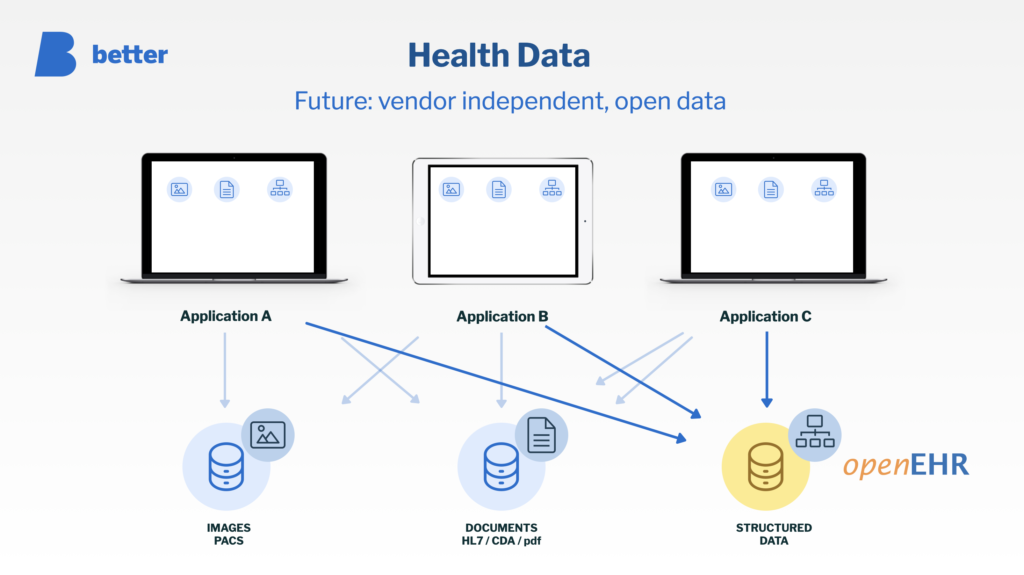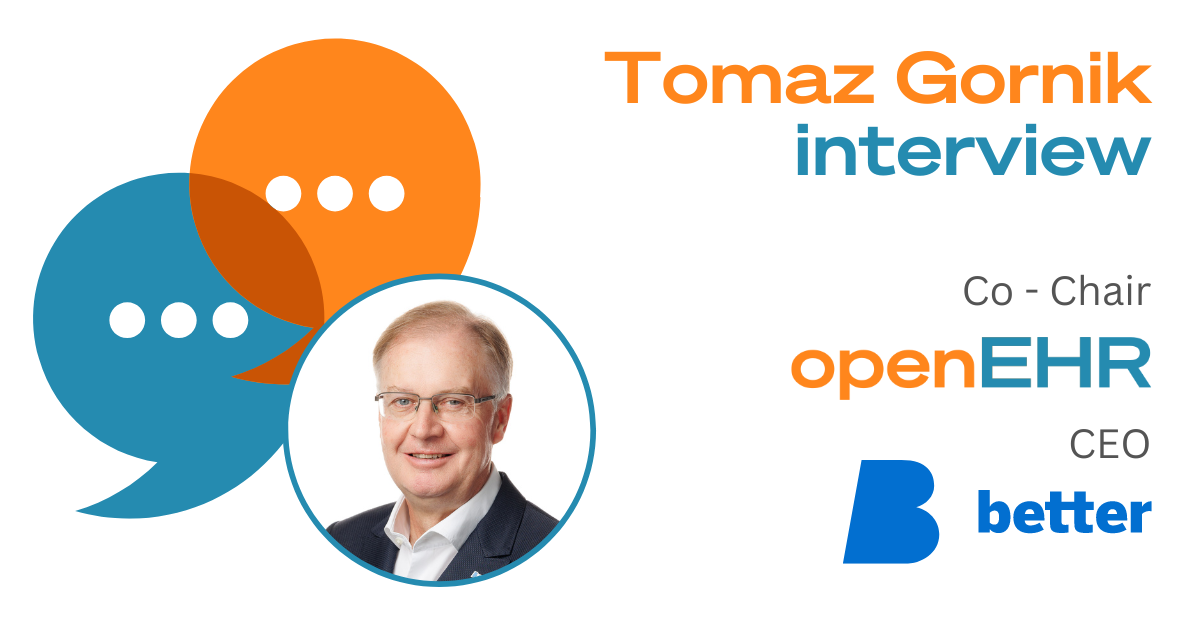When did you discover openEHR?
My openEHR journey started when I stumbled upon it in a Microsoft document about a common user interface for healthcare, which referenced the website ‘openehr.org’. This was around twelve years ago, while we were building an EHR for a children’s hospital in Slovenia. Despite having an oncology solution, we needed a more flexible way to store data for the ten specialties of pediatrics. That’s when I found openEHR, and even though it was still in its early days, it seemed like the perfect solution.
Initially, we faced some challenges, as the available tools were not up to scratch. We had to license the backend from Ocean for two years while we built our application. Later, we replaced the server without changing the application, which was a wake-up call for us because it highlighted the uniqueness of the technology. Despite the steep learning curve, we were determined to make openEHR easier to use. So, we started building a platform and tools like the Archetype Designer, which recently surpassed 3,000 users.
At the same time, we were also promoting the message of separating data from applications, although it was a difficult concept for customers to grasp initially. Nonetheless, we had some early adopters. The first was Moscow City, which was a turning point for us.
Tell us more about the Moscow deal
To be honest, it all came down to a chance meeting. During an event, I ran into a guy I knew from working in telecommunications, and he mentioned he was now working in healthcare in Moscow. A week later, he called me and told me about a tender in Moscow that was similar to what we were working on with openEHR.
In the end, Moscow City trusted us to provide a platform for their entire healthcare system, comprising 12 million patients and over 1,000 institutions.
What challenges did you face when implementing openEHR on such a large scale?
After working with Moscow, we became quite ambitious and received enough funding to develop our digital health platform further. We also spent a lot of time making sure the system performed well, which was a big challenge initially with openEHR due to its different approach. For example, in one weekend, Moscow decided to upload a billion lab results, which was hard for any technology to handle, but we learned a lot from this experience.
They are currently running 20 servers in a big cluster, managing petabytes of information, and serving 150,000 users on the system with 12 million patient records. This makes it among the biggest EHRs in the world, operating as an operational data store and not a data warehouse.
Of course, due to sanctions, we do not have a contract with Moscow anymore, but they are still running the software as far as we know.
Where did you go next?
All the applications were built by the Moscow team, and when we presented our approach to the NHS, which was seven or eight years ago, they were impressed but there were no tenders available for platforms at the time.
We asked the NHS what they were lacking, and they revealed that 80% of their trusts did not have medication management or EPMA. This was a surprise since we had already implemented this in the children’s hospital in Slovenia, even though paediatrics medication prescribing is the most complex.
So we proposed adapting our system to the UK market and the NHS was enthusiastic about the idea. They sent a chief pharmacist to Slovenia for six months to assist us in adapting to NHS requirements. It took us two years of selling and navigating to finally gain our first customer in Plymouth. We integrated our Better Meds into their infrastructure, and that gave us a foothold to approach other NHS Trusts. We’re working with twelve now.
We’re also bidding on all of Wales for Better Meds and will be announcing our expansion to over 60 hospitals in Catalonia soon. Our approach of coming in with a familiar application and providing our platform as a foundation was the only way to go, except for some early adopters like Moscow.
But of course the pandemic changed everything. Suddenly, everyone realised the need for better data, and tenders for platforms are popping up everywhere now. The surprise for us is that openEHR is becoming popular in the most developed markets like the Nordics, UK, and Spain, which we didn’t anticipate. The reason is that organisations in these markets have been collecting health data for decades, understand the issues and shortcomings of current approaches well, and are looking for a better approach.
What international markets is Better targeting now and what is their strategy for expansion?
Back in 2012 when our international story first began, we presented a slide that we still use today – separating the three types of data (images, documents, and structured data) from applications.

This approach immediately made sense to everyone. However, the challenge was finding the right applications and replacing the existing ones. To address this problem, we developed the concept of the postmodern EHR. This involves integrating our approach with the existing infrastructure, starting with new applications and gradually replacing legacy applications, one at a time. The key difference is that we build on a vendor-neutral, common data model, allowing everyone to connect to the same data instance instead of creating silos of disconnected applications. This idea is gaining momentum, thanks in part to the efforts of Jordi Piera Jimenez in Catalonia, who has been instrumental in its success. Interestingly, it is usually a visionary individual rather than a government that brings about change like this. The strategies are changing, and we are excited to see where this approach takes us.
Over the next ten years, I spent most days on flights traveling across Europe, to the Middle East, the US, South America, and Asia. We even had a great deal in the Philippines with 100 small clinics running as well as partnerships with Telstra and Alcidion for Australia and NZ. And recently, our partners in Nigeria built a light EHR using Better platform and we also signed the first deal in the US. So we are now present on most continents!
What type of partners do you look for?
As a product company, we look mainly for services partners – system integrators, and software vendors who can use our products to complement their offering. For example, our partner Alcidion relies on our Better Meds solution as their default option, and they have proven to be a great partner for Meds. In fact, they are one of the rare partners that can handle the entire process themselves, without us being involved in the implementation. All in all, Alcidion does a fantastic job.
Do openEHR and FHIR compete or do they co-exist?
The reality is that we need both. FHIR is built for data exchange, and openEHR shines at health data persistence. There are many technical reasons for this, but mainly it is about using the right tool for the job. At Better, while we store clinical data in openEHR, we use FHIR APIs to connect to applications. This gives us the best of both worlds – we can use the flexibility and richness of openEHR archetypes to store all health data and FHIR APIs, supported by many application vendors, to access it. I see this being the preferred option for many of our customers and most of the recent large projects in Europe.
Where is the business heading next?
With almost 150 installations, our Better Digital Health Platform footprint has grown significantly. Our biggest market remains the UK, where we build on the success of many wins but in particular OneLondon’s Universal Care Plan. Care coordination underpinned by a health data platform using low-code tools to build care plans was delivered in just seven months, providing a model of joining up care for other ICSs as well. Surrey and Borders Partnership NHS Foundation Trust and Sussex Health and Care ICS are two recent wins based on the same concept.
We’re also making inroads in Switzerland with Basel University Hospital being the first. Our biggest OEM partner, Tieto, runs their Lifecare EHR in 60 installations across Finland. Recently, seven regions in Sweden announced an RFI for an openEHR platform and tools, making it the next big target market. And Karolinska University Hospital decided to start a transition from their current monolithic main EHR and instead based their new strategy on an ecosystem that includes an openEHR platform. This is a game changer, as it is the number one hospital in Europe.
Exciting news came just a few weeks ago with our first deal signed in the US, which was announced last week. It’s currently a shared care record which sits between systems they have and is aimed towards Medicare patients, specifically managed by Medical Home Network in seven US states. It’s only the beginning, but it’s a promising pilot that opens up a huge market for us.
What is your vision for the company?
Essentially, our goal is to address the unique challenges that come with healthcare by enabling the sharing of executable content: data models, templates, forms, widgets, algorithms, and more. We believe that by forming communities of individuals and organisations willing to share this information, we can promote the adoption of best practices and ultimately improve patient outcomes. To accomplish this, we are creating a low-code environment that allows for the assembly of applications, rather than development from scratch, making it easier to build and improve upon existing systems.
This isn’t without its challenges, of course. Healthcare is a notoriously difficult industry to recruit developers in, and the backlog of applications that need to be built is enormous. Our focus is on creating a system that can be customised to three key parameters: a doctor’s specialty, a patient’s unique state and comorbidities, and the care setting. If we can get that right, we will revolutionise the way doctors and patients interact with technology.
Our focus is on the clinical aspects of healthcare, rather than administrative or financial details that can vary widely. Our partners are joining us in this effort, and we are working to professionalise openEHR and find individuals who can devote full time to this mission. As co-chair of openEHR and CEO of Better, it’s a blessing and a curse to wear both hats, but our goals are aligned and I’m still excited about the potential impact of our work.

Leave a Reply